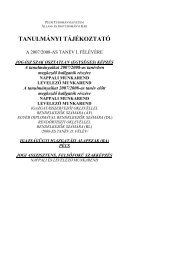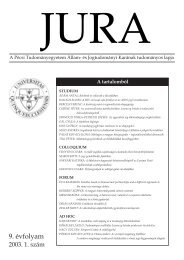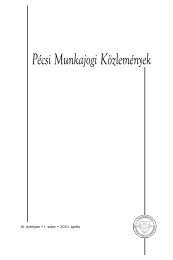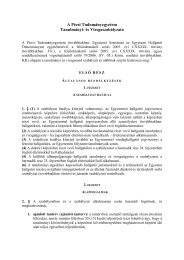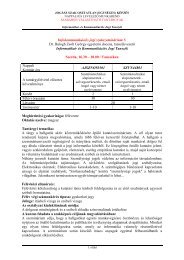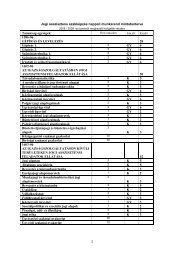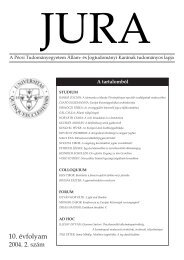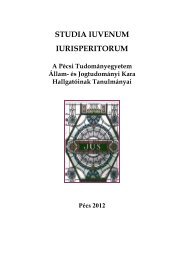2012. évi 2. szám - Jura - Pécsi Tudományegyetem
2012. évi 2. szám - Jura - Pécsi Tudományegyetem
2012. évi 2. szám - Jura - Pécsi Tudományegyetem
- TAGS
- jura
Create successful ePaper yourself
Turn your PDF publications into a flip-book with our unique Google optimized e-Paper software.
142 Andityas Soares de Moura Costa Matos: An alternative approach to the basic norm …sen’s basic norm as a hypothesis means limiting itsfield of epistemological validity. On the other hand,seeing it as transcendental – not transcendent, just likethe fundamental norms of the natural law – meansthat the Grundnorm is intended to be used a priori,i.e., it is entirely independent from experience, astaught by Kant. Thus, unlike more primitive positivistpositions – e.g., those of the School of Exegesis –,in assuming that the Kelsen’s basic norm is free fromthe burden of establishing the content of particularrules to be studied by legal science (Luf 2007, 224),since it needs merely to demonstrate how subjectivesenses of the ought can be understood as objectivecommandments (legal norms), which only seemspossible if we assume the anti-metaphysical closurerepresented by the Grundnorm.The similarities between Kant’s proposal in thefield of natural sciences and Kelsen’s in the legalsphere are well known. 6 Let us recall a few of them.Just as Kant’s categories of sensibility (time andspace) and of understanding (quantity, quality,relation and modality) are pure forms, i.e., conceptswithout any content, that do not establish anythingin material terms to natural laws, but make thempossible, i.e., thinkable, the dynamic basic norm,characteristic of contemporary legal systems, is alsoempty with regards to content (Kelsen 1997, 421) anddoes not determine any specific legal duty, unlikethe static basic norms which guide the natural legalorders. 7 By embracing certain central value that willbe used to deduce all other norms of the legal system,the basic norm (in its static perspective) makes thelegal order unmovable and barren, unable to modifyitself beyond the major value, something that doesnot happen to the contemporary legal systems withtheir open structure of indeterminacy. This is onlyfeasible because the system’s basic norm is empty,allowing the norms dependent of it bear any content(Kelsen 1986, 70). The ought included in the formulaof the basic norm – e.g., “the commands of the firsthistorical generally effective constitution must becomplied” – represents only a logical connective,without any particular deontic content, reflecting,in the words of Luf, a mechanical-causal model ofcognition (Luf 2007, 233). We could say it in a betterway: a mechanical-normative model of cognition.Kelsen’s basic norm restrains the legal cognitionto juridical materials that are given by experience, beinguseless for the cognition of absolutes, such as thenotions of justice, which are common in the naturallaw thinkers (Hammer 2007, 184). The Grundnormmakes the epistemological creation of law possible,because, by limiting its object, it ends up offering aspecific form of existence through the reference to afounding ought (Sollen). Similarly, Kant’s categoriesof sensitivity and understanding turned impossiblethe access to an unconditional is (Sein), i.e., the thingin itself (noumenon). Actually, they create the knowledgeobjects for the sciences of nature, no longerbased in themselves, but rather in the look of theviewer. Behold, in simpler terms, the “CopernicanRevolution” of Kant, which teaches us to considernot the object itself (noumenon), unknowable, but theobject as perceived by the sensitivity and rationalizedby the understanding, i.e., the phenomenon.Based on this logic, we can refute the criticisms(v.g. Celano 2000, 187) according to which, at theend of the day, Kelsen’s basic norm would have anideological nature because it is based on consent –whether informed or not – of persons under specificlegal authority. Thus, criticisms can depart from avery famous example offered by Kelsen when referringto natural law: the ultimate reason for a Christianto love his enemies can be found only in the personalauthority of Christ, the founder of Christian morality(Kelsen 1986, 326). However, it doesn’t seem difficultto understand the radical distinction which permeatesboth normative orders: the Christian normativeorder is of static character because it was based ona value – Christian love –, from which are createdother norms through deduction; while the legal orderis based on an empty form (able to substantiateany content). Therefore, the dynamic legal systemdoes not necessarily need the consent of the peoplesubmitted to it. It is enough to present general effectiveness,as we shall see later.According to Roy’s interpretation, the Christiannormative system (as described above) is not a dynamicorder because it does not have an empty basicnorm that defines competences, while determinessomething like: “the norms set fourth by Jesus mustbe obeyed”. Such a norm doesn’t bear any legalcontent, serving only to enable the interpretation ofsome subjective meanings of ought as being objective(Roy 1997, 12-13). This reading is entirely consistentwith Kelsen’s doctrine, for whom the natural lawfallacy – to derive norms (natural law commandments)from facts (nature) – can be mastered onlywhen we presuppose an empty basic norm thatdefines normative competences (Kelsen 1998b). Thisis the essential concept of a basic norm, i.e., a normin which the content matches the form, which is justa fancy way of saying that it has no content (Edel2007, 219). Indeed, the Grundnorm shows itself, primarily,as a norm that defines competences, capableof connecting the idea of ought (a specifically legallogical structure) to the notion of lawmaker authority(Edel 2007, 218). Already in 1934, in the first editionof the “Pure Theory of Law”, this was the Kelsen’sunderstanding: “The basic norm confers on the actJURA 2012/<strong>2.</strong>



